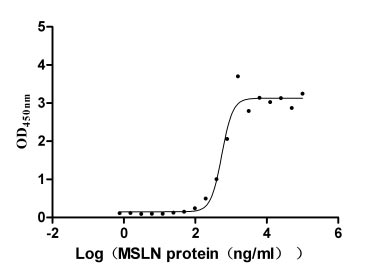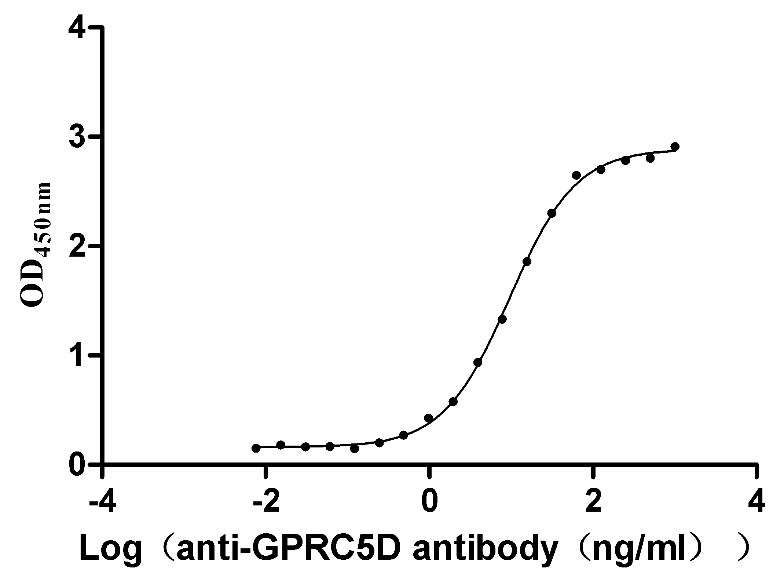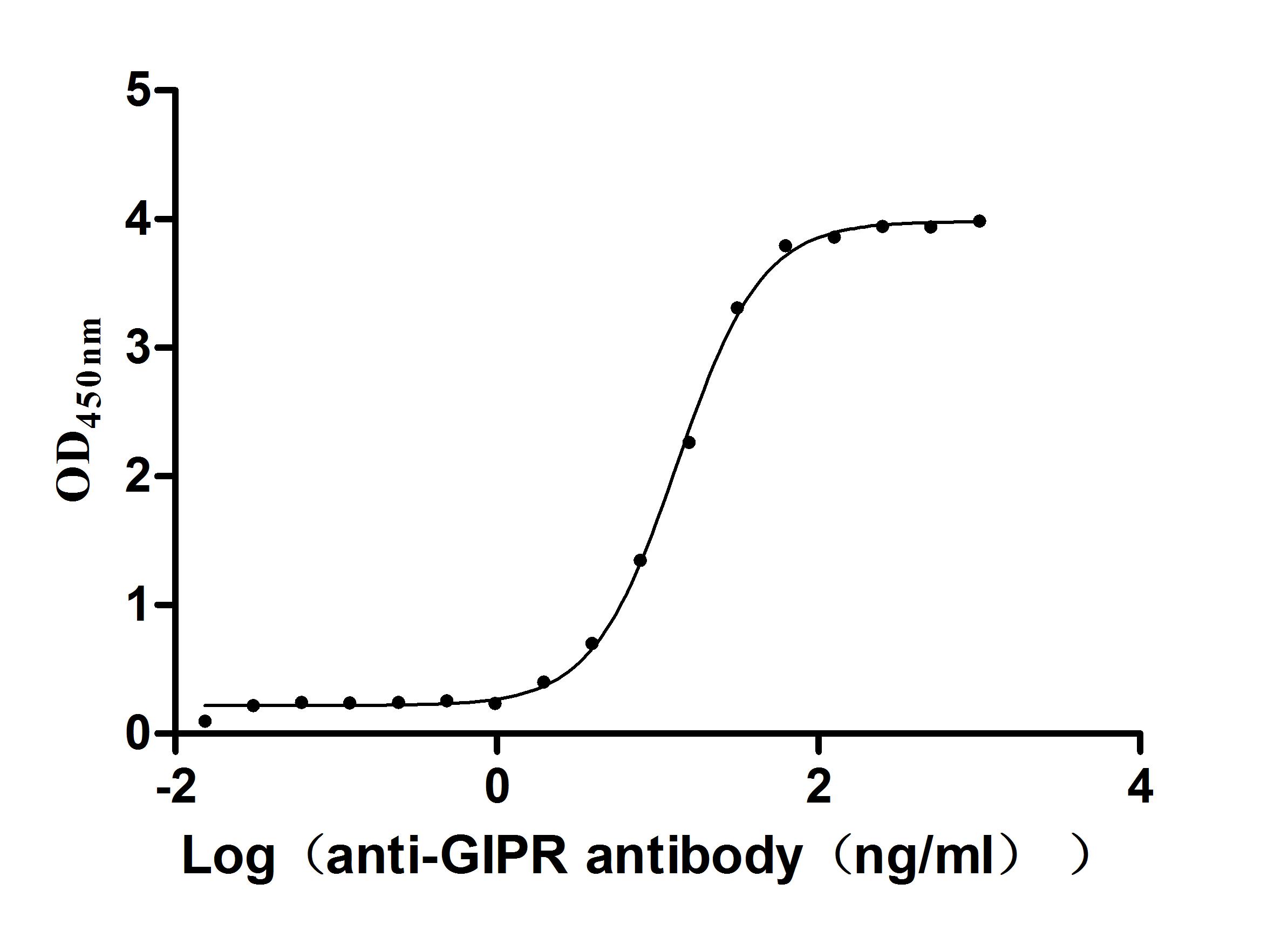Recombinant Mouse Angiotensin-converting enzyme 2 (Ace2), partial
-
货号:CSB-YP851244MO
-
规格:
-
来源:Yeast
-
其他:
-
货号:CSB-EP851244MO
-
规格:
-
来源:E.coli
-
其他:
-
货号:CSB-EP851244MO-B
-
规格:
-
来源:E.coli
-
共轭:Avi-tag Biotinylated
E. coli biotin ligase (BirA) is highly specific in covalently attaching biotin to the 15 amino acid AviTag peptide. This recombinant protein was biotinylated in vivo by AviTag-BirA technology, which method is BriA catalyzes amide linkage between the biotin and the specific lysine of the AviTag.
-
其他:
-
货号:CSB-BP851244MO
-
规格:
-
来源:Baculovirus
-
其他:
-
货号:CSB-MP851244MO
-
规格:
-
来源:Mammalian cell
-
其他:
产品详情
-
纯度:>85% (SDS-PAGE)
-
基因名:
-
Uniprot No.:
-
别名:Ace2; Angiotensin-converting enzyme 2; EC 3.4.17.23; ACE-related carboxypeptidase) [Cleaved into: Processed angiotensin-converting enzyme 2]
-
种属:Mus musculus (Mouse)
-
蛋白长度:Partial
-
蛋白标签:Tag type will be determined during the manufacturing process.
The tag type will be determined during production process. If you have specified tag type, please tell us and we will develop the specified tag preferentially. -
产品提供形式:Lyophilized powder
Note: We will preferentially ship the format that we have in stock, however, if you have any special requirement for the format, please remark your requirement when placing the order, we will prepare according to your demand. -
复溶:We recommend that this vial be briefly centrifuged prior to opening to bring the contents to the bottom. Please reconstitute protein in deionized sterile water to a concentration of 0.1-1.0 mg/mL.We recommend to add 5-50% of glycerol (final concentration) and aliquot for long-term storage at -20℃/-80℃. Our default final concentration of glycerol is 50%. Customers could use it as reference.
-
储存条件:Store at -20°C/-80°C upon receipt, aliquoting is necessary for mutiple use. Avoid repeated freeze-thaw cycles.
-
保质期:The shelf life is related to many factors, storage state, buffer ingredients, storage temperature and the stability of the protein itself.
Generally, the shelf life of liquid form is 6 months at -20°C/-80°C. The shelf life of lyophilized form is 12 months at -20°C/-80°C. -
货期:Delivery time may differ from different purchasing way or location, please kindly consult your local distributors for specific delivery time.Note: All of our proteins are default shipped with normal blue ice packs, if you request to ship with dry ice, please communicate with us in advance and extra fees will be charged.
-
注意事项:Repeated freezing and thawing is not recommended. Store working aliquots at 4°C for up to one week.
-
Datasheet :Please contact us to get it.
相关产品
靶点详情
-
功能:Essential counter-regulatory carboxypeptidase of the renin-angiotensin hormone system that is a critical regulator of blood volume, systemic vascular resistance, and thus cardiovascular homeostasis. Converts angiotensin I to angiotensin 1-9, a nine-amino acid peptide with anti-hypertrophic effects in cardiomyocytes, and angiotensin II to angiotensin 1-7, which then acts as a beneficial vasodilator and anti-proliferation agent, counterbalancing the actions of the vasoconstrictor angiotensin II. Also removes the C-terminal residue from three other vasoactive peptides, neurotensin, kinetensin, and des-Arg bradykinin, but is not active on bradykinin. Also cleaves other biological peptides, such as apelins, casomorphins and dynorphin A. By cleavage of angiotensin II, may be an important regulator of heart function. By cleavage of angiotensin II, may also have a protective role in acute lung injury. Plays an important role in amino acid transport by acting as binding partner of amino acid transporter SLC6A19, regulating its trafficking on the cell surface and its activity.
-
基因功能参考文献:
- ACE2/A1-7/Mas axis may be one of the intra-islet paracrine mechanisms of communication between alpha and beta cells. Enhancing the ACE2/A1-7 axis exerts a protective effect by ameliorating beta cell dedifferentiation. PMID: 29225087
- ACE2 is a novel factor required for exercise-dependent modulation of adult neurogenesis and essential for serotonin metabolism. PMID: 29679094
- High ACE2 expression is associated with acute lung injury. PMID: 29990483
- These results were supported by the opposite outcomes observed for cells treated with A779 or DX600. Therefore, it was concluded that the ACE2-Ang(17)-Mas axis significantly inhibits pancreatitis by inhibition of the p38 MAPK/NF-kappaB signaling pathway PMID: 29138810
- Exogenous ACE2 alters angiotensin peptide metabolism in the kidneys of Col4a3 knockout mice and attenuates the progression of Alport syndrome nephropathy. PMID: 28249676
- Profound augmentation of ACE2 confined to the circulation failed to ameliorate the glomerular lesions and hyperfiltration characteristic of early diabetic nephropathy. PMID: 27927599
- Nrf2-mediated stimulation of intrarenal Renin-Angiotensin syste, (CAE2 and MasR) gene expression, by which chronic hyperglycemia induces hypertension and renal injury in diabetes. PMID: 29211853
- In islets from db/db mice, ACE2 over-expression increased intracellular calcium influx and restored impaired mitochondrial oxidation, potentially causing an increase in GSIS. These results shed light on the potential roles of ACE2 in mitochondrial metabolism, moreover, may improve our understanding of diabetes. PMID: 29128354
- Ultra-high doses did not influence the ACE2/AT2R/Mas axis and promoted renal injury with increased renal ERK1/2 activation and exaggerated fibronectin expression in db/db mice. Our study demonstrates dose-related effects of candesartan in diabetic nephropathy: intermediate-high dose candesartan is renoprotective, whereas ultra-high dose candesartan induces renal damage. PMID: 27612496
- Altogether, our study demonstrates that HFD feeding increases RAS activity and mediates glycemic dysregulation likely through loss of ACE2 present outside the islets but independently of changes in islet ACE2. PMID: 27806985
- Results suggest that angiotensin converting enzyme 2 may reduce anxiety-like behavior by activating central Mas receptor that facilitate GABA release onto pyramidal neurons within the basolateral amygdala. PMID: 26767952
- These findings demonstrate that ACE2 plays a critical role in preventing RSV-induced lung injury, and suggest that ACE2 is a promising potential therapeutic target in the management of RSV-induced lung disease. PMID: 26813885
- ACE2 overexpression significantly reduced the myocardial infarction-induced increase in apoptosis, macrophage infiltration, and HMGB1 and proinflammatory cytokine expression. PMID: 26498282
- ACE2 regulates vascular function by modulating nitric oxide release. PMID: 27070147
- MAS receptors mediate vasoprotective and atheroprotective effects of candesartan upon the recovery of vascular ACE2-angiotensin-(1-7)-MAS axis functionality PMID: 26144375
- ACE2 plays a novel role in heart disease associated with obesity wherein ACE2 negatively regulates obesity-induced epicardial adipose tissue inflammation and cardiac insulin resistance. PMID: 26224885
- a Mas receptor-mediated mechanism may stimulate pancreatic cell development PMID: 26029927
- ACE2 deficiency exacerbates kidney inflammation, oxidative stress and adverse renal injury in the ApoE-mutant mice through modulation of the nephrin, NOX4 and TNF-alpha-TNFRSF1A signaling. PMID: 26245758
- Hydronephrosis led to an increase of ACE level and a decrease of ACE2 and Mas receptor in the heart. PMID: 25650385
- Overexpression of ADAM17 increases shed ACE2 and decreases cellular ACE2 levels in pancreatic islets. Whereas ADAM17 has the ability to shed ACE2, ADAM17 does not deplete ACE2 from pancreatic islets in diabetic db/db mice. PMID: 26441236
- ACE2 and Ang-(1-7) significantly inhibit early atherosclerotic lesion formation via protection of endothelial function and inhibition of inflammatory response. PMID: 25721616
- These results demonstrate a critical role for endogenous ACE2 in the adaptive beta-cell hyperinsulinemic response to High Fat feeding through regulation of beta-cell proliferation and growth. PMID: 26389599
- ACE2 deficiency worsened the influenza pathogenesis markedly, mainly by targeting the angiotensin II type 1 receptor (AT1). PMID: 25391767
- Placental hypoxia and uterine artery dysfunction develop before major growth of the fetus occurs and may explain the fetal growth restricted phenotype in Ace2 knock-out pregnant mice. PMID: 25968580
- Beneficial effects of E2 to decrease blood pressure in ovariectomized obese females may result from stimulation of adipose ACE2. PMID: 26078188
- In experimental mouse models, infection with highly pathogenic avian influenza A H5N1 virus results in downregulation of angiotensin-converting enzyme 2 (ACE2) expression in the lung and increased serum angiotensin II levels. PMID: 24800825
- Whole-body deficiency of ACE2 significantly increased aortic lumen diameters and external diameters of suprarenal aortas from AngII-infused mice. PMID: 25301841
- Brain-targeted angiotensin-converting enzyme 2 overexpression attenuates neurogenic hypertension by inhibiting cyclooxygenase-mediated inflammation. PMID: 25489058
- Partial loss of ACE2 is sufficient to enhance the susceptibility to heart disease. PMID: 24728465
- Suggest that the ACE2-ACE imbalance plays an important role in the pathogenesis of severe acute pancreatitis and that pancreatic ACE2 is an important factor in determining the severity of SAP. PMID: 24414175
- Expression of ACE2 reduced the fibrosis. PMID: 24695436
- Angiotensin converting enzyme 2/Ang-(1-7)/Mas axis protects brain from ischemic injury via the Nox/ROS signaling pathway, with a greater effect in older mice PMID: 24581232
- ACE2 deficiency promotes the development of vascular diseases associated with Ang-II-mediated vascular inflammation and activation of the JNK signalling, leading to the notion that ACE2 potentially confers protection against vascular diseases. PMID: 24193738
- Proximal tubular shedding of ACE2 may increase in diabetes. PMID: 24454948
- This study also shows that serum and urine ACE2 activity is increased in the NOD mouse model of diabetes starting at an early stage of the disease. PMID: 24400109
- Loss of ACE2 exacerbates AngII-mediated inflammation, myocardial injury and dysfunction in ACE2-deficient hearts via activation of the CTGF-FKN-ERK and MMP signaling. PMID: 24161906
- Suggest that ACE2 plays a key role in the recruitment of the renal reserve and hyperfiltration associated with diabetes. PMID: 24477684
- blockade of the AT1 receptor by azilsartan could enhance the activities of the ACE2/Ang-(1-7)/Mas axis and ACE2/Ang-(1-7)/AT2 receptor axis, thereby inhibiting neointimal formation. PMID: 24379178
- These results suggest that ACE2 plays an important role in postnatal development of the heart, and that lack of ACE2 enhances coronary artery remodeling with an increase in perivascular fibrosis and cardiac hypertrophy already around the weaning period. PMID: 23608725
- ACE2 has a protective role in murine renal ischemia-reperfusion injury. PMID: 23951161
- ACE2 was downregulated in apelin-deficient mice. Apelin, via activation of its receptor, APJ, increased ACE2 promoter activity in vitro and upregulated ACE2 expression in failing hearts in vivo. ACE2 couples the RAS to the apelin system. PMID: 24177423
- Unlike angiotensin-converting enzyme 2, collectrin lacks any catalytic domain. PMID: 24048198
- Urinary ACE2 could be a potential biomarker of increased metabolism of ANG II in diabetic kidney disease. PMID: 23761674
- A cardioprotective and vascular protective role is documented for ACE2 under pathological conditions. PMID: 23043153
- This review summarizes and discusses the structure and multiple functions of ACE2 and the relevance of this key enzyme in disease pathogenesis. PMID: 23328447
- ACE2 metabolizes ANG II in the kidney at neutral and basic pH, while prolylcarboxypeptidase catalyzes the same reaction at acidic pH. PMID: 23392115
- Upregulation of the angiotensin-converting enzyme 2/angiotensin-(1-7)/Mas receptor axis in the heart and the kidney of growth hormone receptor knock-out mice PMID: 22947377
- Severe acute pancreatitis is associated with upregulation of the ACE2-angiotensin-(1-7)-Mas axis and promotes increased circulating angiotensin-(1-7). PMID: 23127535
- ACE2 protects against high-calorie diet-induced insulin resistance in mice. This mechanism may involve the transcriptional regulation of GLUT4 via an A1-7-dependent pathway. PMID: 22933108
- ACE2 deficiency impaired endothelial function in cerebral arteries from adult mice and augmented endothelial dysfunction during aging. PMID: 23160880
显示更多
收起更多
-
亚细胞定位:[Processed angiotensin-converting enzyme 2]: Secreted.; Cell membrane; Single-pass type I membrane protein. Cytoplasm. Cell projection, cilium. Apical cell membrane.
-
组织特异性:Expressed in heart, kidney and forebrain (at protein level). Expressed in the small intestine, with expression in the intestinal brush border (at protein level). Ubiquitously expressed, with highest levels in ileum, kidney and lung. In lung, expressed on
-
数据库链接:
KEGG: mmu:70008
STRING: 10090.ENSMUSP00000073626
UniGene: Mm.13451
Most popular with customers
-
Recombinant Human Mucin-16 (MUC16), partial (Active)
Express system: Mammalian cell
Species: Homo sapiens (Human)
-
Recombinant Mouse Prolactin receptor (Prlr), partial (Active)
Express system: Mammalian cell
Species: Mus musculus (Mouse)
-
Recombinant Human G-protein coupled receptor family C group 5 member D (GPRC5D)-VLPs (Active)
Express system: Mammalian cell
Species: Homo sapiens (Human)
-
Recombinant Human Cannabinoid receptor 1 (CNR1)-VLPs (Active)
Express system: Mammalian cell
Species: Homo sapiens (Human)
-
Recombinant Human Desmoglein-2 (DSG2), partial (Active)
Express system: Mammalian cell
Species: Homo sapiens (Human)
-
Recombinant Human CD81 antigen (CD81), partial (Active)
Express system: Mammalian cell
Species: Homo sapiens (Human)
-
Recombinant Human C-C chemokine receptor type 6(CCR6)-VLPs (Active)
Express system: Mammalian cell
Species: Homo sapiens (Human)
-
Recombinant Macaca Gastric inhibitory polypeptide receptor(GIPR), partial (Active)
Express system: yeast
Species: Macaca fascicularis (Crab-eating macaque) (Cynomolgus monkey)




















